The Euroline Essential Collection is the Budget Side of Bob Kramer: Great for Arthritis, and a Challenge for the Small Handed
This knife has been out a long time, so there’s already been a lot of discussion about it. There was already too much discussion about the Bob Kramer / Zwilling team up before the knife itself even hit the shelves.
So I’m late to the game, with this review, because I spent a lot of time comparing it to other top production chef knives, but I did manage to get a couple of unique takeaways from using this knife over the course of about a month:
- It’s great for people with big hands,
- It’s even better for people with arthritis,
- And it feels pretty natural to people who are used to using cleavers.
It took us a while to get to any Zwilling Kramer knives because I’m not much of a cook, and a Kramer knife never felt like something I should have.
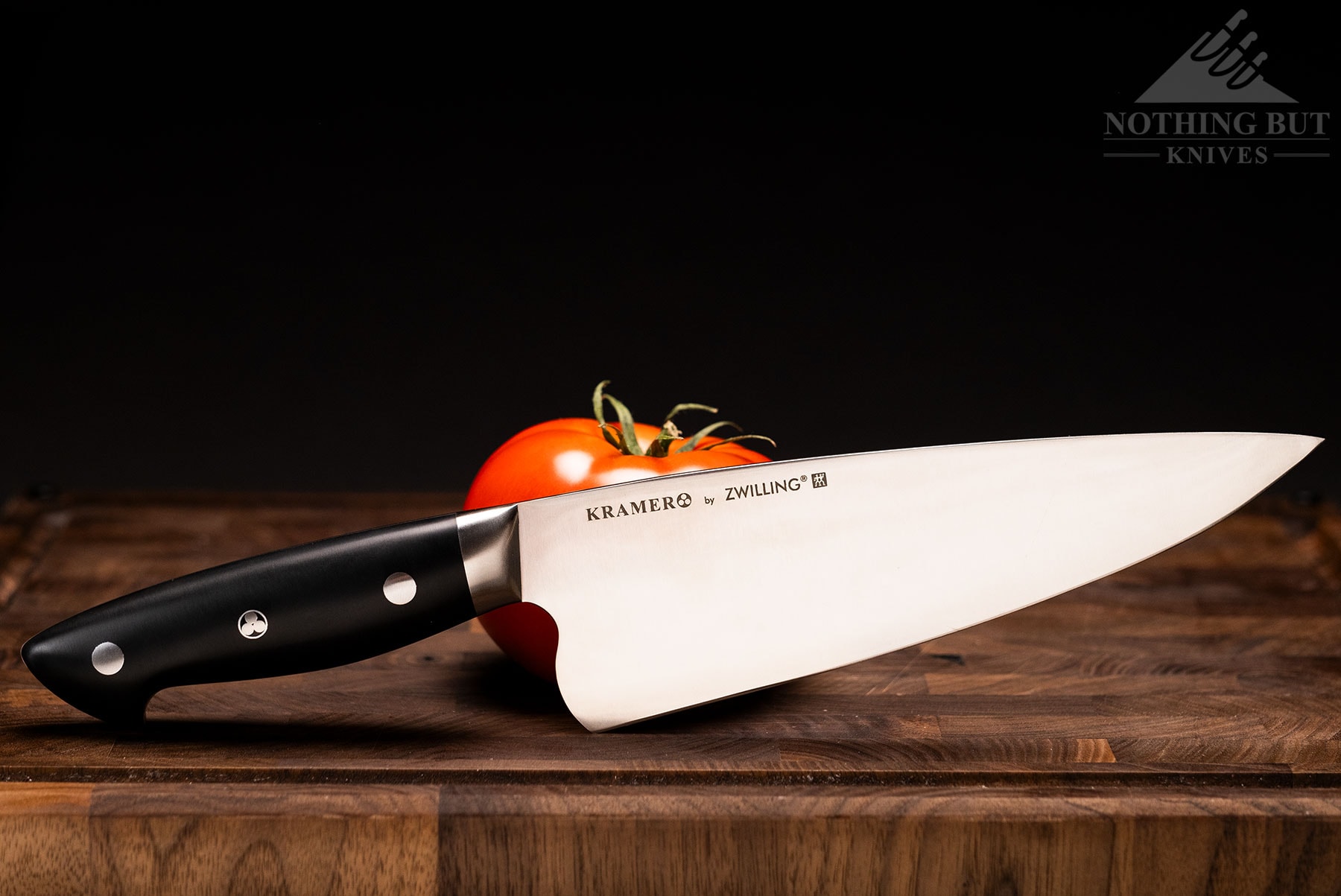
Zwilling has released a few different models in their Kramer line in the years since the first carbon version came out, though, one being a slightly more budget friendly stainless steel model. And while something still feels wrong about any Kramer knife being tested by a jackass who’s more used to crushing nuts with the handle of an ax than fileting a fish in a kitchen, the stainless steel Zwilling Kramer feels almost as approachable as the Wusthof Classic Ikon. Which is enough that I don’t feel as bad about testing it to see how well it can cut the weird plastic ring they put on half gallons of ice cream.
Specifications
| Overall Length: | 13.125” |
| Blade Length: | 8.0” |
| Blade Steel: | FC61 |
| Hardness: | 61 HRc |
| Blade Thickness: | 0.16” |
| Blade Shape: | Modified Western Chef |
| Blade Grind: | 9 – 12 degree full flat |
| Handle Length: | 5.125” |
| Handle Material: | Brushed polymer |
| Weight: | 9.66 oz |
Pros
| Super comfortable |
| Well balanced and much lighter than it looks |
| HIghly versatile blade with great knuckle clearance |
| Stainless steel with tough, easy-maintenance properties |
| Apparently it’s great for people with arthritis |
Cons
| A lot of food stick |
| Doesn’t fit any standard knife block or saya |
| Fat handle can feel intrusive if you aren’t used to this kind of shape |
| Fit and finish isn’t seamless |
On the Bob Kramer Name, Prices, and Zwilling Kramer Options
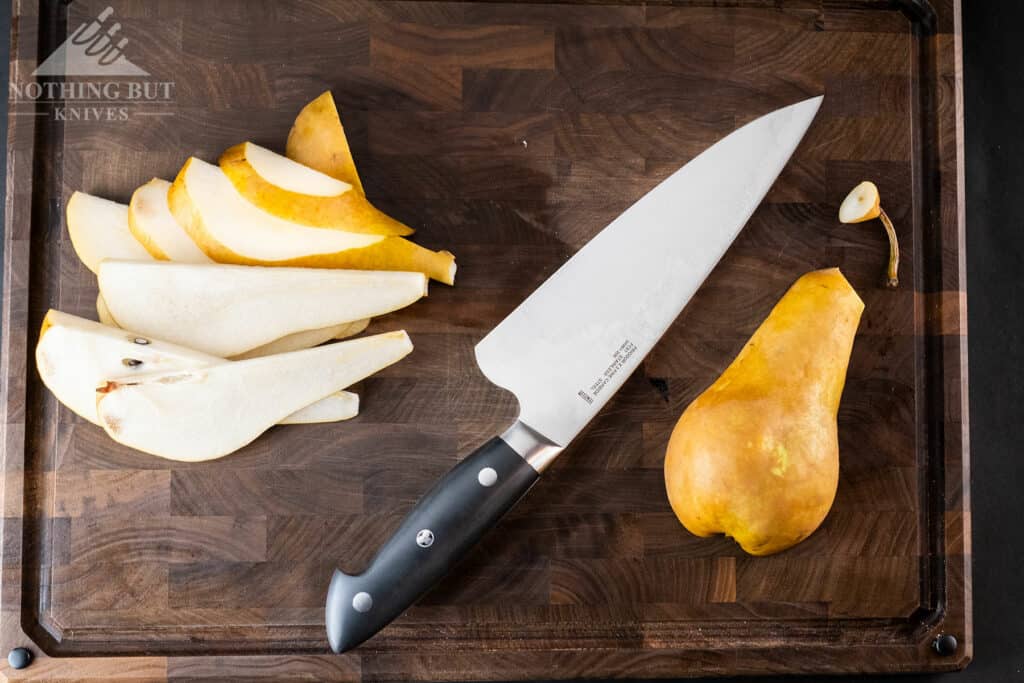
I doubt I’m telling anyone anything new here, but I’d feel left out if I didn’t get my chance to say “Bob Kramer is a master blade smith whose knives sometimes auction for the price of at least three kidneys in good condition”. He’s a cook turned sharpener turned blade smith, and has become the gold standard for Michelin star chefs the world over.
The only way to get a knife made by him from his actual shop is to go through the auction process on his site. But Zwilling approached Kramer about licensing some designs from him back around 2010, making the Kramer name more readily accessible to the grubby peasants who just want to drop $400 and get their knife without having to battle a hundred other collectors clutching their credit cards and polishing the empty spot on their kitchen counter for when their grail knife shows up in three years.
All that to say that I’m reviewing the poor man’s Kramer here. Even among the cheaper Zwilling-made Kramer knives, the Kramer Essential is at the bottom of the price range, which might not align with whatever gold-embossed vision the reader has for their kitchen when they first typed “German Kramer knife good?” into Google. The Essential Collection is still considered to be high end cutlery by most folks. It’s just a little more affordable than the other Kramer By Zwilling knife series.
But the Zwilling Euroline Essential is close enough to the other western-handled Kramers that most of what I say about it here should still be a good estimate of how the others feel and cut with the exception of the thinner-handled Meiji Kramers. The main difference is the steel, which I’ll get into more later.
Just to lay the context out clear, here are the other options offered by Zwilling (The prices are averaged between a few different vendors but God knows the exact numbers are likely changing day to day).
- Euro Essential (roughly $250)
- Meiji (roughly $270)
- Carbon 2.0 (roughly $350)
- SG2 Damascus (roughly $430)
The Thick Handle and Big Hand Ergonomics
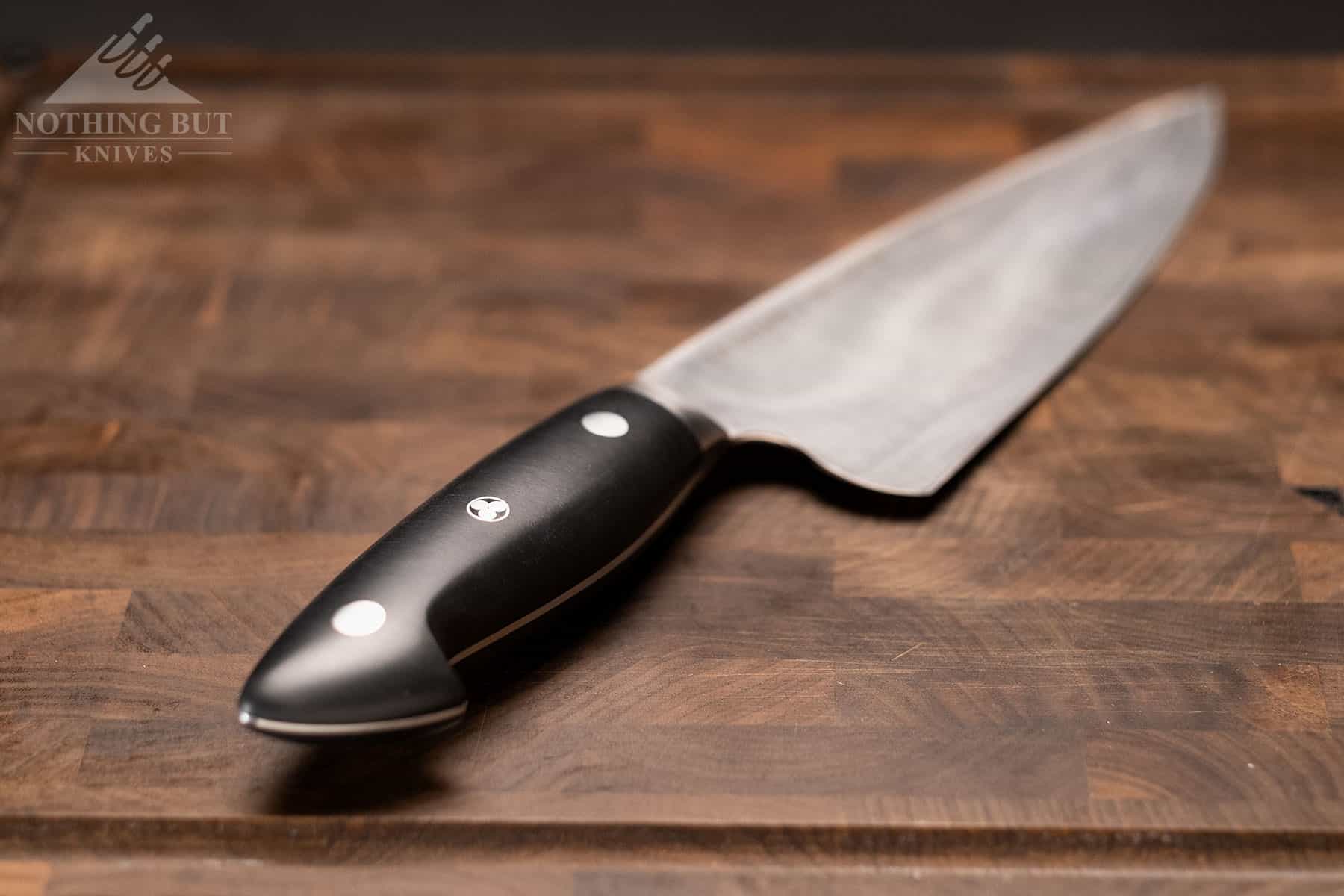
The biggest surprise for me was how light this Kramer is. By sight, I expected it to be heavy, even after I read the roughly 9.5 oz weight measurement listed by most vendors. It’s an incredibly satisfying experience to pick this up, feel how light it is, then grip it and feel how well balanced it is.
It’s easy to get comfortable with this thing, and the way the spine is crowned makes it a lot more pleasant to push into harder cuts in a pinch grip, and it has a good feeling of security in a full handle grip. Putting aside any critique of the way it cuts (or the way I cut), this knife is so light and well balanced and easy to hold onto that I forgot I was holding something expensive.
Full Grip Comfort and the Arthritis Benefit
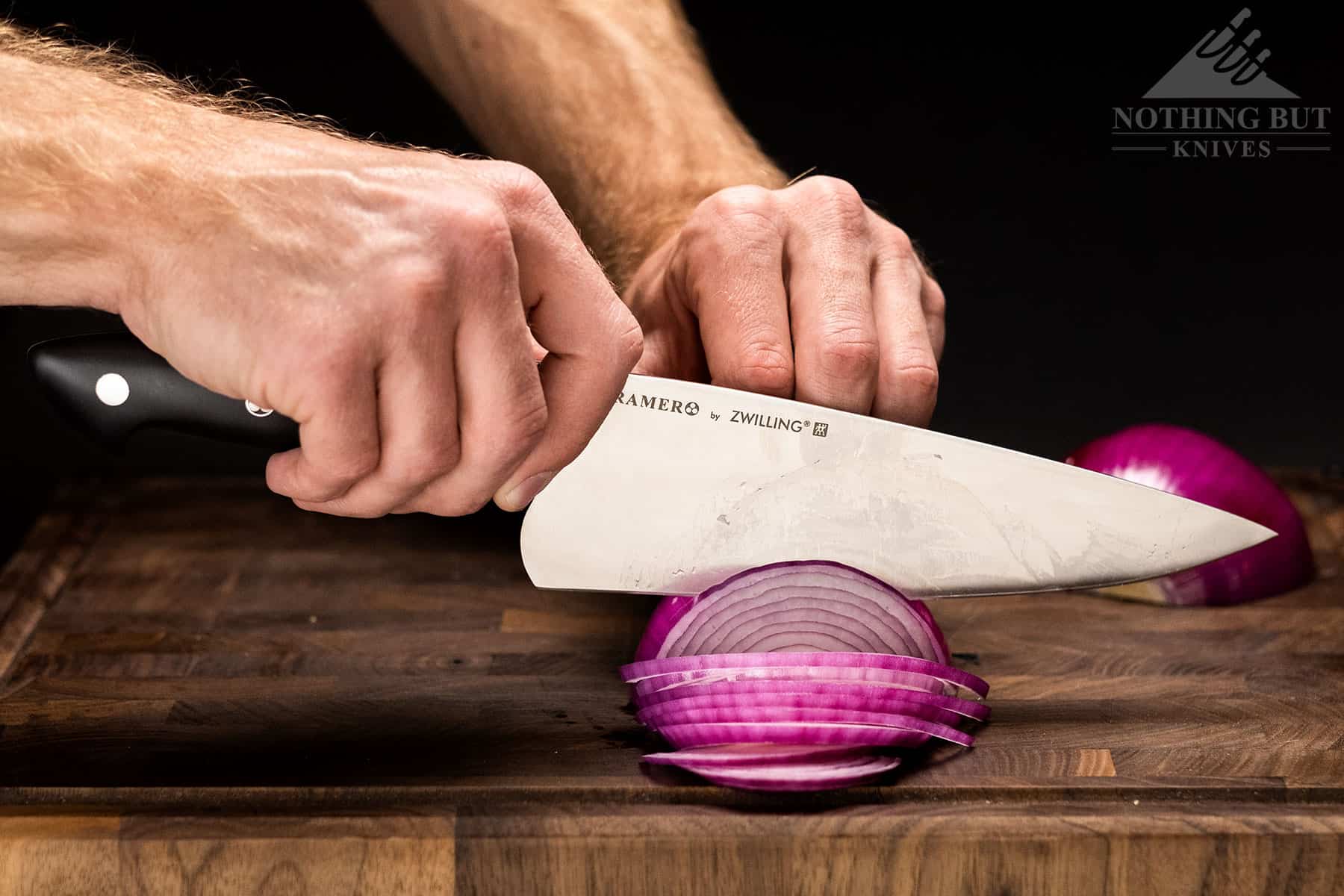
That does bring up kind of a tricky element of this thing, though. Anyone who holds this knife properly in a pinch grip isn’t going to benefit much from the fat handle outside of the balance it provides. In fact I found the fat handle to be a little bit intrusive at first. But for the less proper home cooks out there who gorilla grip their knives, the Kramer handle can have a much larger benefit, especially for those with arthritis.
This is one of the few high-end kitchen knives my mother has enjoyed using, because the handle is so large that her hand doesn’t need to close as much or as tightly to secure her grip. She has arthritis in her wrist, but she said she didn’t feel any strain at all when she was cutting a mix of vegetables that included a few hard carrots.
This is, by the way, coming from a woman who has told me on many occasions that she doesn’t want to use sharp knives because she’s afraid of cutting herself. I’ve brought all kinds of both Japanese and Western knives to her, and invariably her review of them boiled down to “it’s nice but too sharp for me”.
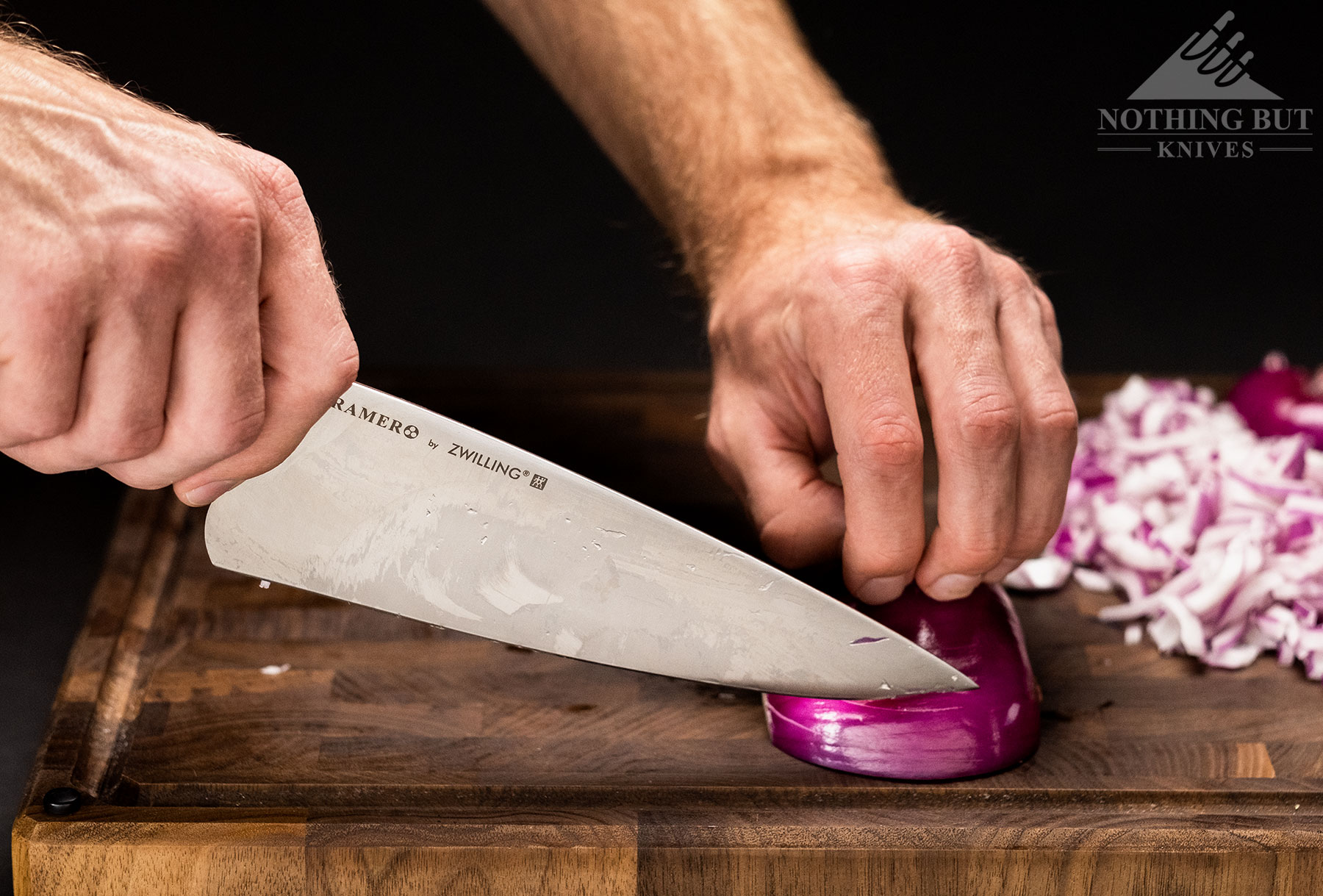
This Kramer is not lacking in the sharpness department. It could be a little better (I’ll get into that more later), but it cut paper well enough to pass the “too sharp for my mother” test. So for my mother to feel completely comfortable as she makes perfect, smooth cuts through a carrot is an achievement I haven’t seen from any other handle design.
For those without arthritis or a fear of sharp knives, that level of comfort translates more practically to staving off hand fatigue. I haven’t spent a forty hour work week cutting with the Zwilling Kramer, but I have made a few dinners with a few piles of potatoes and onions. I haven’t noticed my hand cramping up, or even feeling all that tired outside of the kink in my neck as I lurch over whatever mess of vegetables and meat I’ve made on the cutting board, which actually brings up another convenient element of this particular model.
Cleaning and Maintenance
This is the easy-maintenance version. The “cheap” version for people who don’t always hold their food very well, and when they’re cutting too many different things they get it mixed up and all over their hands, and by the time they’re actually ready to throw anything into a pan the knife is covered tip to handle in onion bits, lime juice, and maybe just a dab of their own blood.
This is the kind of person who has to wash the handles of their knives a lot. In the short term, that’s not a huge problem, but if you have a nice knife with wood or Micarta handles (like the Zwilling Kramer Carbon or Damascus) then you’re setting yourself up for a little scale warping down the road. The composite handle on this stainless Essential version doesn’t have that. It’s messy-idiot proof in that sense.
The Rock Chopping Blade
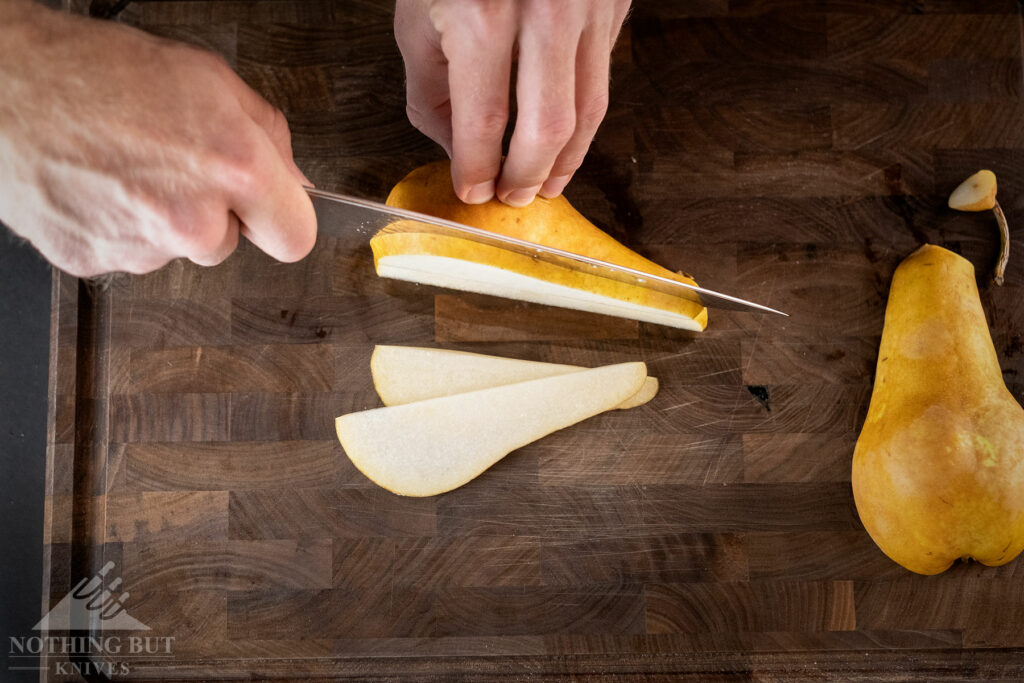
The blade is great. The edge is good, but it’s not a laser and that is perfectly acceptable in this context. I only say that because I’m worried the expectation of most people when they get a knife in this price range is that it’s going to have a super biting edge that splits atoms out of the box. Especially when Zwilling lists it as having a 9 to 12 degree grind.
This is a western-style knife, though, and in true western style the edge is sharp but the blade is thick.
You can definitely get the edge into laser status if you strop it, and I think that’s one of the highlights of this knife. The factory edge works just fine, but there’s plenty of knife for people to play around with if they want it to have a hair popping edge. Plus this steel has been pretty easy for me to hone and sharpen so far.
I liked the factory edge just fine, though. It parts harder foods like carrots pretty gently, almost like a convex grind. It’s a little tricky to complete a cut sometimes because of the curve of the edge, because it doesn’t really have a flat section. In fact if you put the heel of the blade against the cutting board you’ll see how quickly that edge moves up.
Basically what this means is you really need to rock chop with this knife. That curve facilitates that motion very well, and allows for much deeper rock chops, but it will probably take a bit of time to acclimate to its sweet spot, even for someone who’s used to German knives.
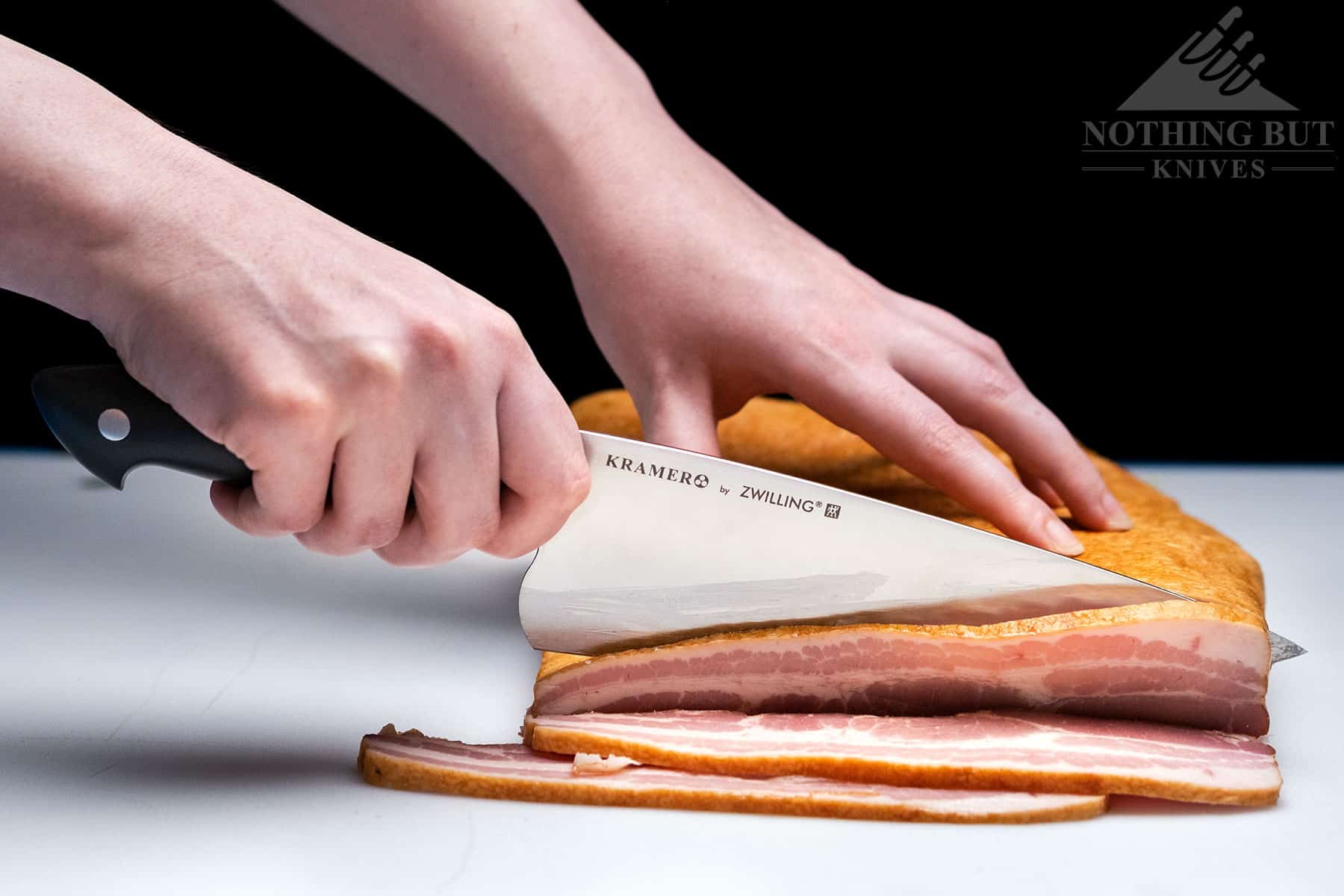
Once, I found that right motion and placement for it, though, this Kramer became incredibly pleasant to use. I’ve used it to make salsa, soup, chili, and sliced up a few different cuts of meat (some with bone). But I’ve talked to people who happily use this for breaking down whole bird carcasses. It’s the kind of knife that finds a way to be useful for any kitchen task.
Blade Construction and the Food Stick
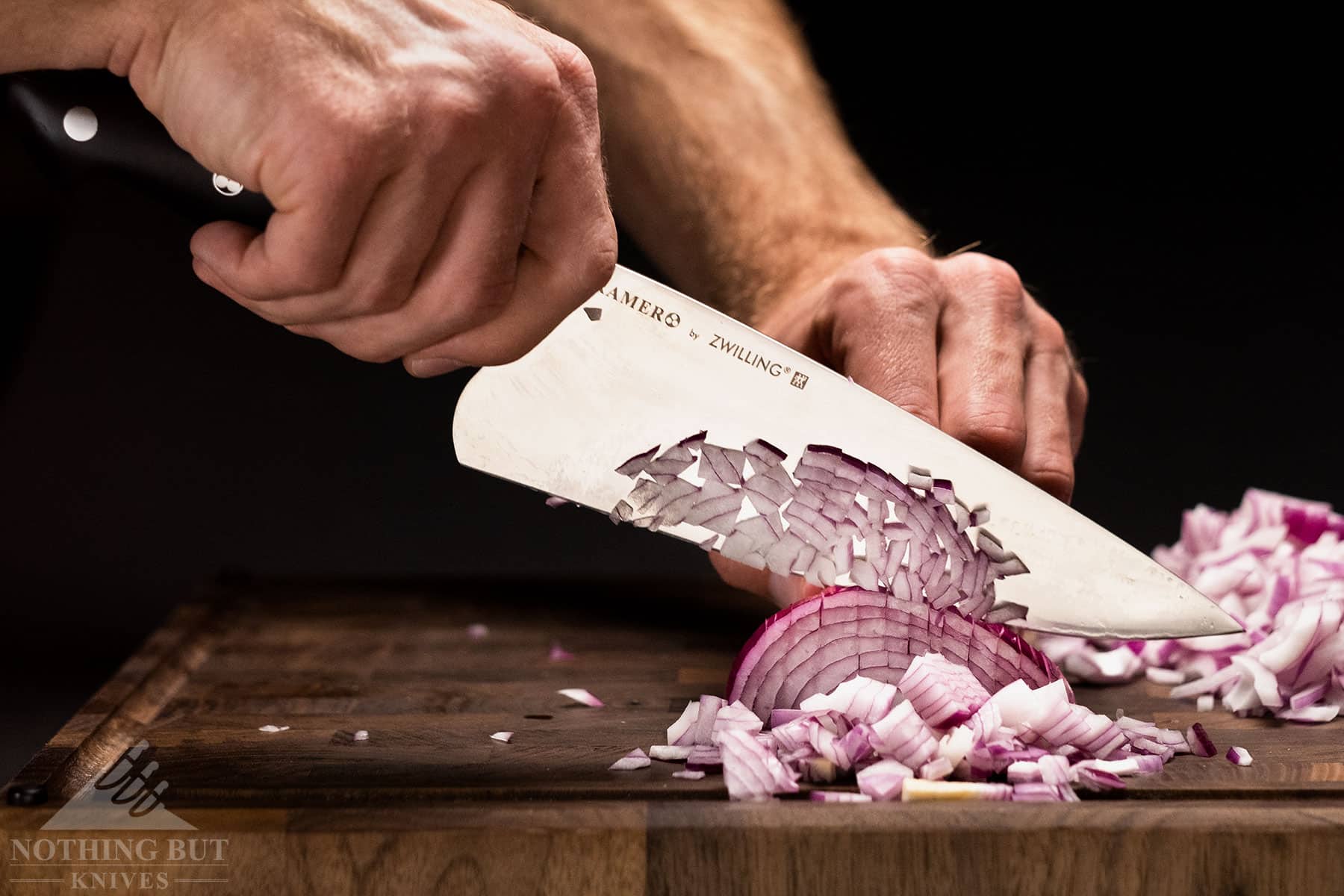
This is a tall blade. Far taller than most people are used to using, even professional cooks and chefs. It wasn’t much of an adjustment for me because I’ve been using my Mattia Borrani chef knife for nearly two years now, and this Zwilling Kramer is only about a half inch taller at the heel, but it honestly doesn’t feel that big when I’m using it.
It has a fantastic distal taper. This blade gets continuously thinner toward the edge and the tip, so it stays fairly thin behind the edge even at the heel. I did experience a bit of wedging when I used the heel to cut things like carrots. But the cuts got a lot easier and cleaner as I went higher up the blade.
I’ve heard there is one major difference between this production knife and a real custom Kramer knife: the edge grind. This knife is a full flat grind where something coming out of Kramer’s shop will usually have a convex. That can have a range of effects on how a knife cuts, but the most noticeable one for me and incompetent home cooks like me is that the flat grind results in a lot more food stick. That particular issue can get pretty bad because there’s so much blade for food to build up on. That was probably my biggest frustration with this knife.
The Steel: Stainless Stuff vs. High Carbon Stuff
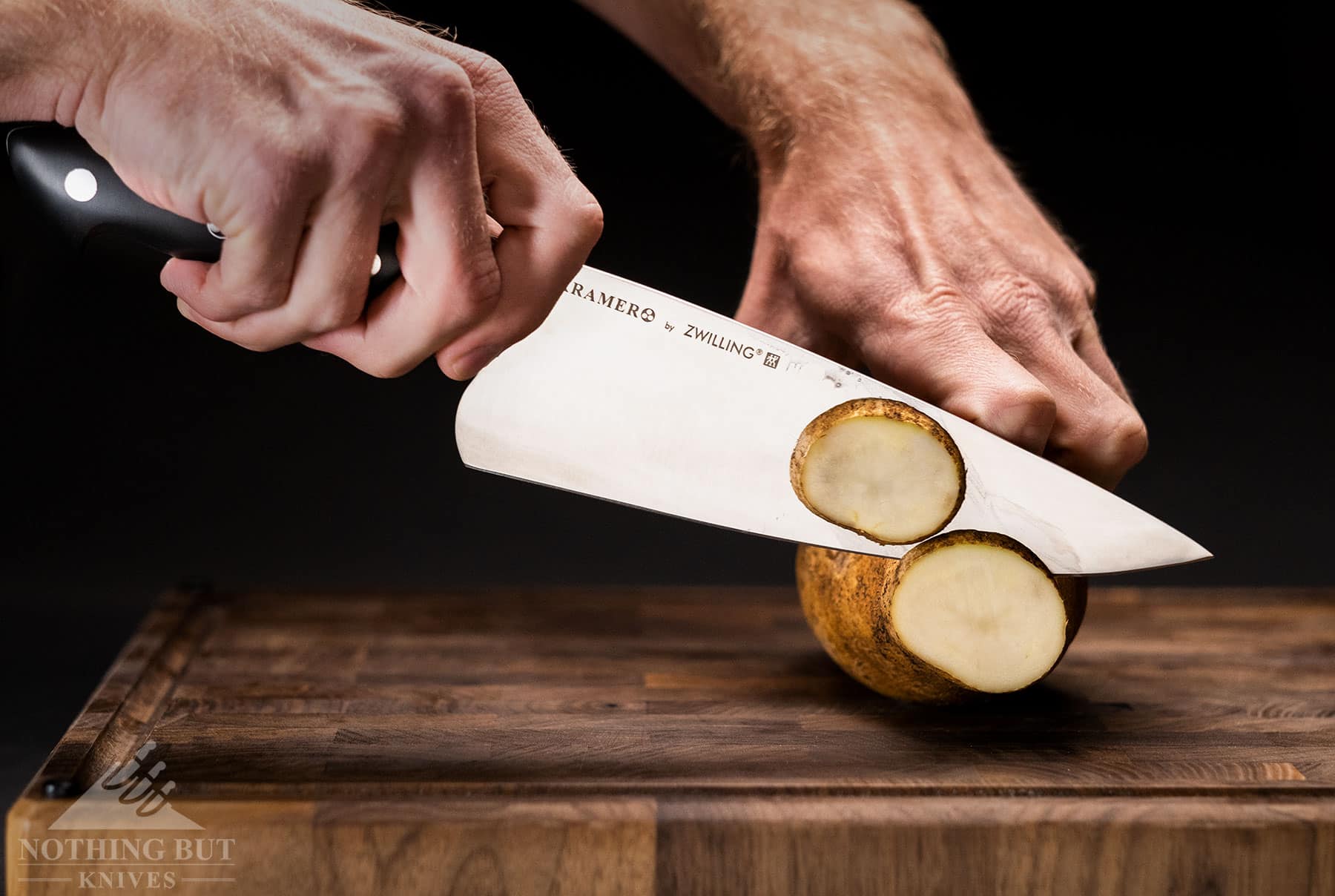
This is the stainless mut in the Zwilling Kramer world. Kramer himself is partial to 52100 high carbon steel because of the way it can take an edge (that’s what’s in the Zwilling Kramer Carbon 2.0). The FC61 in the stainless Zwilling Kramer has its own upsides, though.
FC61 is Henkel’s proprietary version of Sandvik 13C27, which is nearly identical in composition to Bohler AEB-L. If you’ve never heard of any of those steels, the main take away from all those letters and numbers is that this knife has a fine-grained stainless steel that prioritizes toughness over edge retention, but has great edge stability.
It’s also hardened to 61 HRc, which is a touch higher than your standard German chef knife. Normally that would make me concerned about chipping a knife, especially one this size that’s meant to be used around carcasses and boned meat. FC61 seems to be perfectly comfortable at this hardness, though. God knows there were a few times I misused this knife on packaging and some semi-frozen materials, but the most damage I’ve seen in the edge is a little bit of rolling here and there.
So this can take an edge nearly as well as 52100. It can hold that edge better than something like 1.4116, which is what you’ll find in most other western-style knives, and it’s easier to hone and sharpen than other common kitchen knife steels like VG-10. So far I’ve only had to hone the edge to keep it cutting near factory length, so the edge retention isn’t half bad either.
Comparison and Alternatives
I had two other knives nearby as I was testing the Zwilling Kramer: The Wusthof Classic Ikon chef knife, and the Mattia Borrani Bowie Chef knife.
Against the Wusthof Classic Ikon
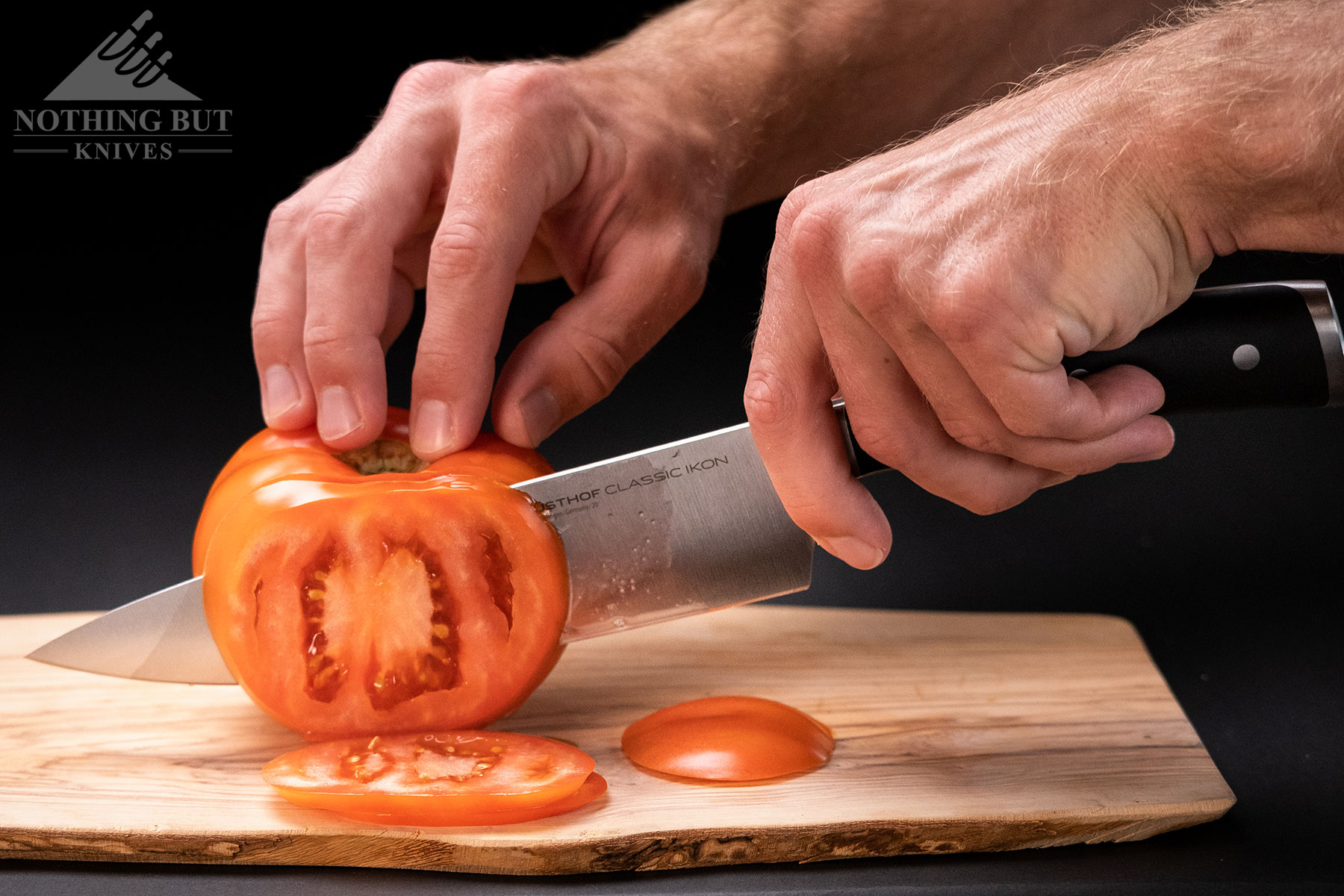
The Wusthof Ikon is usually around $50 cheaper, but it doesn’t cut quite as cleanly because the blade stock is a little wider and the blade isn’t as tall. It’s also very different in terms of weight and balance. So different, in fact, that I’m hesitant to say the Zwilling Kramer is better.
The Kramer is blade heavy. You don’t need to put a lot of pressure into a cut to get it moving. But the Wusthof Classic Ikon has a more dexterous feel to it because the tip is a little more pointed and the handle-heavy balance makes the blade feel lighter.
I did find it a little easier to do julienne cuts on carrots with the Zwilling Kramer, but I’m not sure if that’s because of the difference in grinds or the way the handles feel. The point is that the two knives have very different ergonomics and balance.
Against the Mattia Borrani Bowie Chef Knife
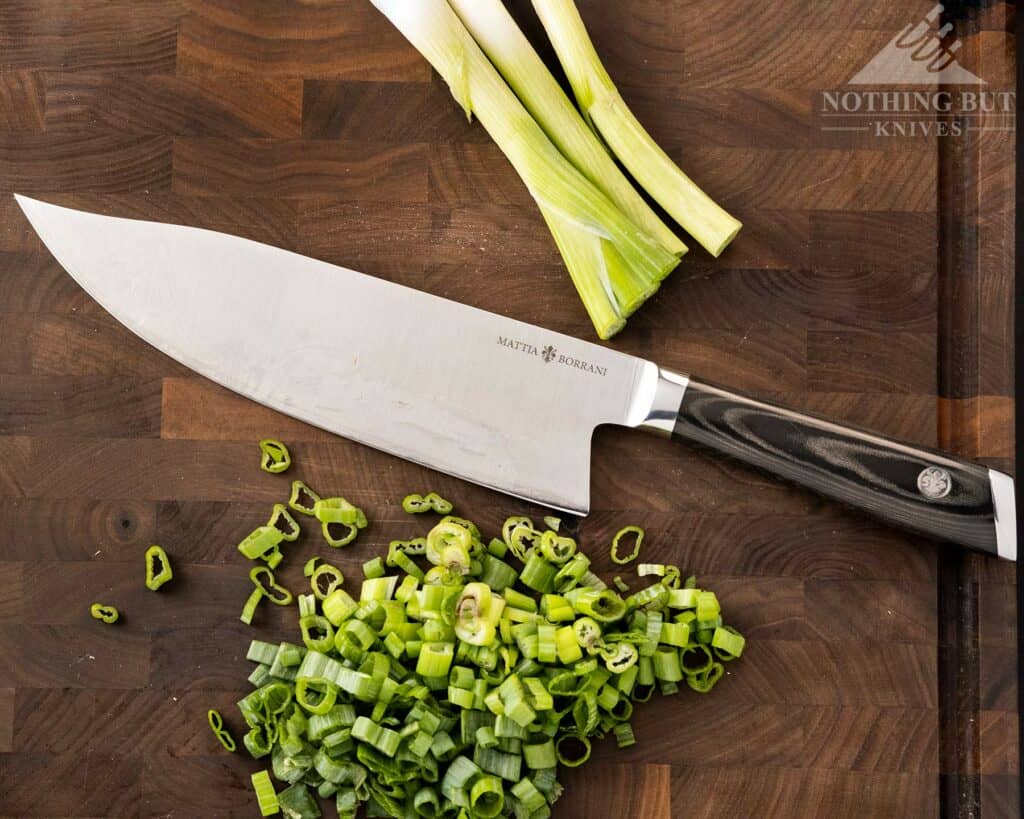
The Mattia Borrani Bowie chef knife is the most similar thing in my collection in terms of blade size. The handle and tip are entirely different, though, and those make all the difference.
It doesn’t cut quite as smoothly as the Kramer, but the food stick is a little better thanks to the slight convex grind. It doesn’t respond as well to a honing rod, but it’s surprisingly close in terms of cutting performance considering the price difference, which is significant if you’re looking at the production version of the bowie. I also like the Mattia Borrani’s handle better because it allows my fingers to kind of splay out behind my hand. For whatever reason that makes it more comfortable for me.
I did find that I didn’t like the dramatic curve at the top of the bowie as much after using the Kramer because I started getting pretty good at using the higher portion of the knife while testing it (since the sweet spots tend to be higher up), then when I switched back to the Mattia Borrani, it was almost like being handicapped because the tip is all but gone the way it curves so far back. They’re both great for rock chopping though.
And I Guess the Dalstrong Shogun X Too
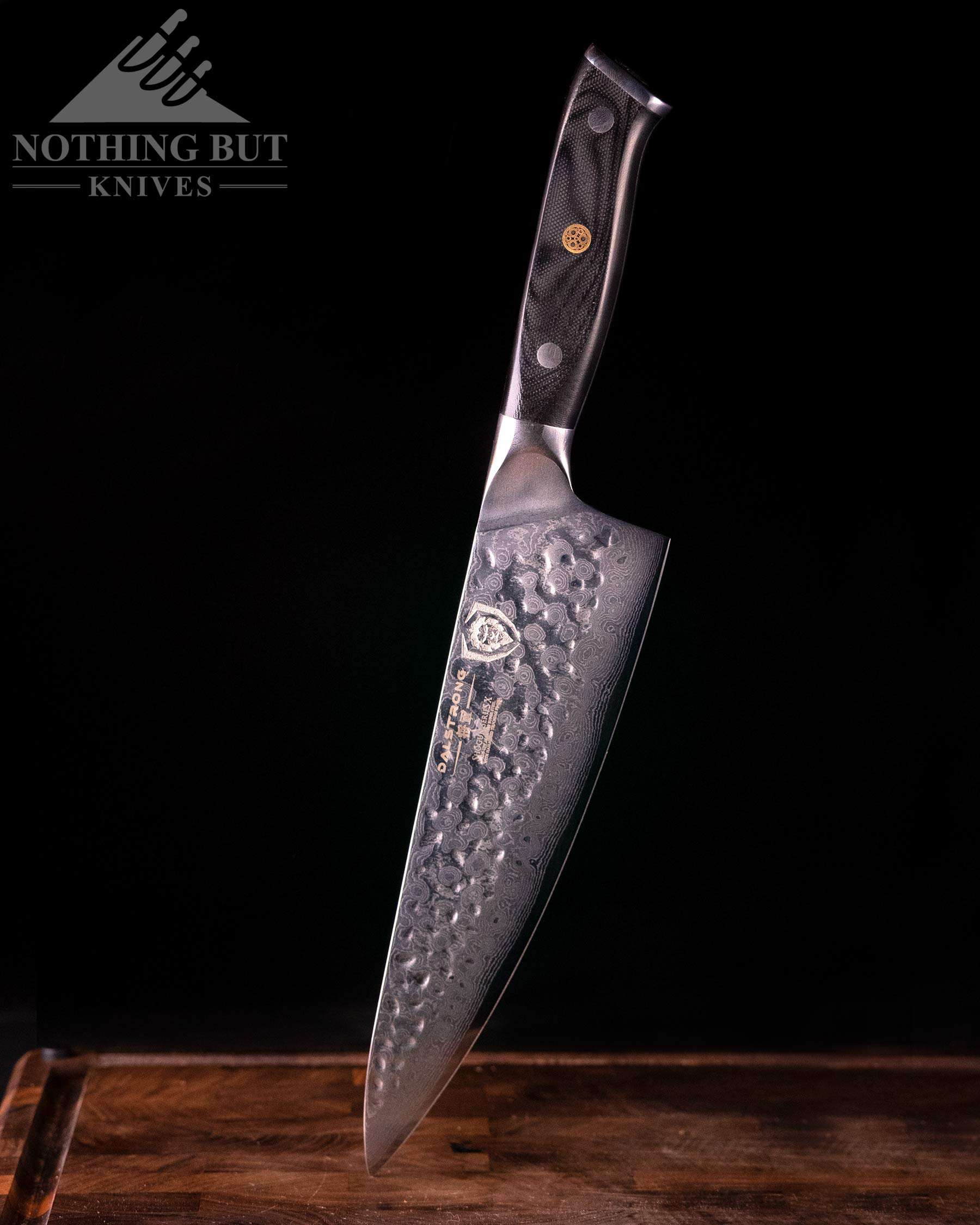
The other comparison that I don’t really want to make, but should, by all rights, is the Dalstrong Shogun X. The lines of the handle and the blade are more similar to the Zwilling Kramer than the dressing might make it seem. They both have larger western-styled handles and tall blades that lean a little toward a gyuto tip.
The Shogun technically has about the same grind, but Dalstrong does not have the same sharpening prowess as the folks in Zwilling’s Seki factory, and they definitely don’t have Bob Kramer’s exacting standards. So the Shogun has a harder bite, but the balance and follow through of the cut feel a lot more awkward to me.
Also it’s hardened to 62+ HRc, so not only is there less blade to work with when you sharpen it, but it’ll be all around harder to hone and sharpen. I’d recommend the Shogun as the cheaper option for people who like fatter handles, but don’t want to fuss with their knife. They just want something that works well enough and looks neat.
The Cangshan Thomas Keller chef knife is a similar but slightly cheaper alternative to the Kramer by Zwilling Essential chef knife
Final Thoughts on this Hard to Find Knife
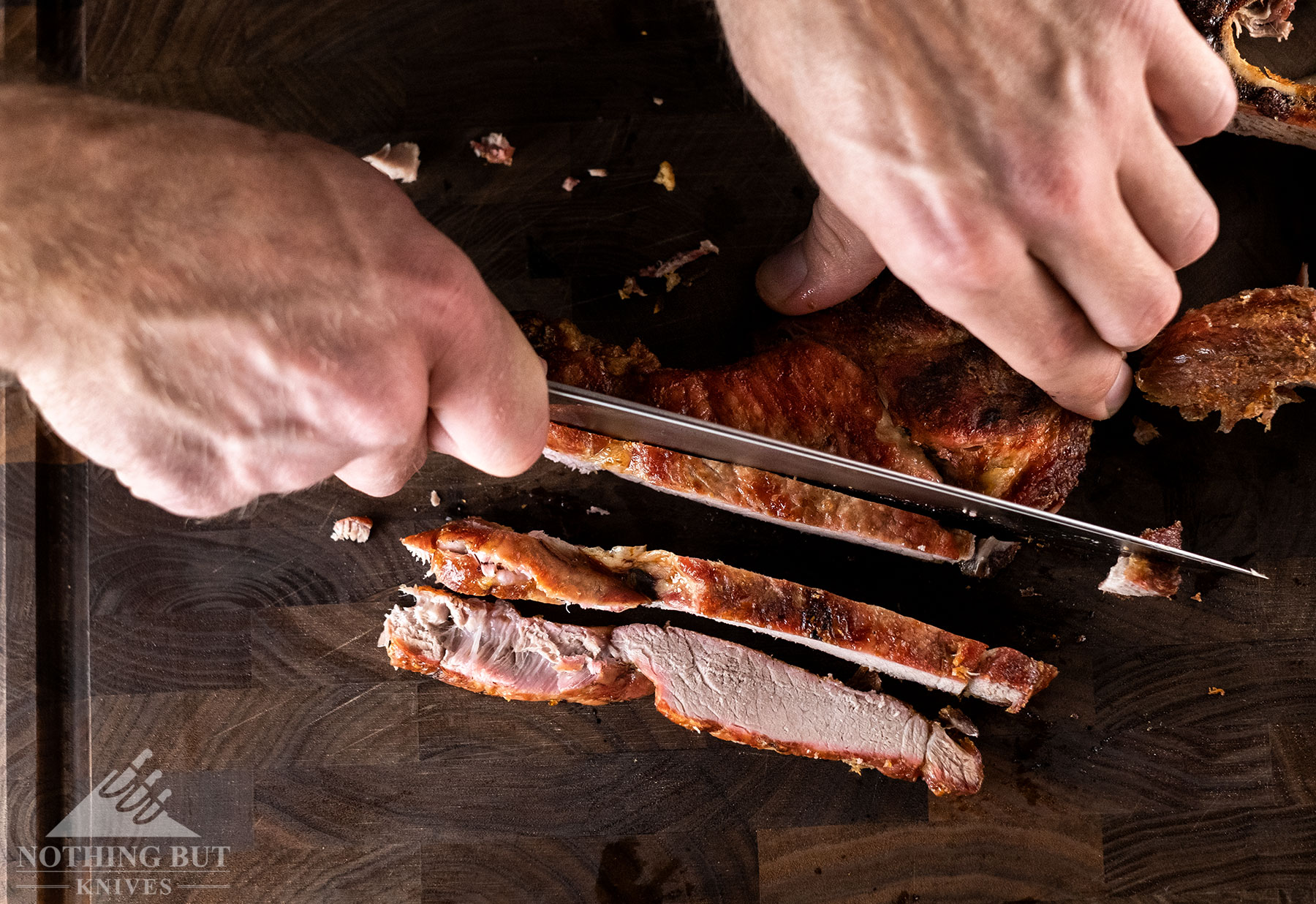
I expected this to be a high performance knife, but the comfort level genuinely shocked me even with high expectations. That stayed true with pretty much everyone I handed this too. The blade performance is all well and good, but the handle and balance are by far the standout reasons to get a Zwilling Kramer chef knife.
That’s not to discount the blade. I think the FC61 steel brings a great compromise between toughness and hardness for this style of knife. It’s also sharp and easy to keep that way, even if you aren’t particularly good at maintaining knife edges. My main problem is that the extreme curvature of the edge is pretty far outside my preference for western-leaning gytutos.
I think the best thing I can say is that this is absolutely the knife to get for your parents. It’s tough and a little flashy, and incredibly friendly to less experienced users. It’s so different from a lot of other chef knives being made these days, though, that I’d be cautious about buying this as a gift for any kind of professional cook. But at the end of the day, this knife is just cool. It has a good story, it looks nice, and it works well.
Also, it’s fun to be able to say “I have a Kramer”.

Being that the Kramer Zwilling essential seems to be no longer available, how do you feel about the Kramer Zwilling Meji. I own several good Shun and Global knives and want to treat myself to a really good chef knife. I think I like the hybrid concept of the Meji. Would appreciate your point of view,
I was glad to come across your site and reviews. Thank you
The Meiji chef’s knife has been on my wish list for a while. I’ve only heard good things about it (from people who had set the price aside for the discussion).
If you already own and like Shun and Global knives, you’ll probably like the Kramer Meiji stuff. The only thing I would caution you about is that the Maiji blades look like they have western profiles: taller blades, bigger bellies, so even though the handles are Japanese style, I don’t think it’ll have the same feeling as a Global gyuto. The sweet spot on the edge will probably be different, and the weight and balance will definitely be different.
Just to give some insight on steel. FC61 is just as tough if not tougher than 52100 and it has better edge retention while being stainless. The only downside is that you can’t harden it quite as high. But compared to 52100 at 61HRC, the steel is better. I think the only reason the simple carbon steels like 52100 are so sought after is a lack of understanding and the mystique around traditional Japanese knife culture.
Not sure 52100 quite counts as a simple carbon steel. It’s definitely high carbon, but has a fair percentage of alloys in its makeup if you’re comparing it to blue or white steels used in traditional Japanese knives. You’re probably right that FC61 is tough or tougher than 52100 in most cases, but my understanding of high carbon steels in general is that they’re a lot more sensitive to heat treatment. It’s not just a matter of saying one is better than another since the result can be vastly different depending on how the steel is handled in the first place, and that’s at least part of the reason so much mystique has built up around using them.
All that to say that I love FC61 (and AEB-L, and 13C26), but I’m not about to tell people to forget about the simpler steels.